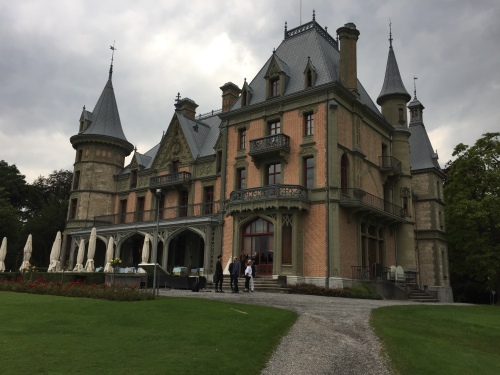 Earlier this month I gave a paper at the ‘Domestic Sphere in Europe, 16th to 19th Century’ conference at the Schloss Schadau in Thun, Switzerland. The conference was run by Joachim Eibach, as part of his NSF-Sinergia-project Doing House and Family, based at the Universities of Bern, Basel, Lausanne and Lucerne.
Earlier this month I gave a paper at the ‘Domestic Sphere in Europe, 16th to 19th Century’ conference at the Schloss Schadau in Thun, Switzerland. The conference was run by Joachim Eibach, as part of his NSF-Sinergia-project Doing House and Family, based at the Universities of Bern, Basel, Lausanne and Lucerne.
In addition to offering a trip into the mountains alongside fondue-eating locals, accompanied by the sound of cow bells, it brought together the largest group of people I’ve ever been in a room with (and a very grand room at that) who are actively engaged in thinking about the pre-modern house. Three days saw a thought-provokingly vast scale of papers, focused across Europe and from the early sixteenth to the nineteenth century. I wanted to draw together a few of the preoccupations that connected them here, to try to lay out the bones of shared concerns in a way that might suggest a way forward for studies of domestic life.
Joachim’s opening thoughts were very useful in establishing a framework for the ensuing discussion. He considered the ‘domestic sphere’ as a focus in relation to more established terms such as ‘family’, ‘household’ and ‘kinship’, and he pointed to the practical focus of the event, on doing, discussing the challenge faced by cultural historians in analysing the self-evident elements of the everyday. The notion of ‘co-presence’, of face-to-face interaction, with its concerns about shared space and communication, became an important strand in the papers. For instance Claudia Opitz-Belakhal spoke about the ‘emotionalised language’ of time spent together, and Julie Hardwick about the ways in which young couples in early modern France calibrated their intimacy in relation to their location – how they tied the registers of inside and outside space to the progress of their relationship.
Another important theme was closure, one of the key elements of the Doing House and Family project. ‘The changing degrees and different ways of ‘doing’ closure and openness of domestic spheres may serve well as a paradigm in family history’, Joachim suggested at the start, and Maria Agren’s summary comments identified a thread of argument through the papers that increased enclosure over time was a significant but complex narrative, with some elements always kept secret and the outside always present through light and glances in both directions through windows. We saw these connections in the papers on religion within the home – in Tine Van Osselaer’s identification of priests and ceremonies brought into the domestic environment, and in Irene Galandra Cooper’s arguments about the relationship between devotional forms used in both the churches and the lower status houses of Naples. The connections were also made evident in Frank Hatje’s argument that we should see bourgeois groups’ need for privacy to read as connected to their investment in patterns of sociability through which they might display that reading. Interesting points were made about openness as involving both inviting people in and talking about the household outside; about the description of relationships as part of their performance (Sandro Guzzi-Heeb) – for me, a larger question emerged – how are physical and narrative experiences of space and co-presence linked to one another at different times and in different places?
But, as was frequently pointed out, levels of closure are not just about modes of accessibility – they provide a key way for historians to understand social control. Focusing on what’s seen and unseen, known and unknown across the threshold is a way of exploring the relationship between the state and the house; the Political and the political; public and private spheres. The opening remarks asked how we might articulate what is apparently a broad shift from the relative heterogeneity of the ‘household family’ to something more nuclear and ‘privatized’; ‘From relatively open ‘mixed zones’ to a retreat into privacy behind walls and curtains (‘Rückzugswohnen’)’? Thinking through that broad chronology as a series of points in time demands a combination of micro-histories of the house with macro-historical questions. This is a crucial task, it seems to me, for the study of early modern domestic process – partly because by undertaking it we get at the heart of early modern identity, and partly because we rescue the study of everyday life from perceptions of triviality and inconsequence.

So what kind of insights were gained in Thun from the micro-macro connection? Inken Schmidt-Voges’ quiet revelation of a ‘conflict biography’ of court case in which upholding the peace was seen to be more important than upholding patriarchal rule demonstrated with great power what is at stake in a fuller understanding of these relationships. Sandra Cavallo’s careful work on annotations on printed medical texts showed that textual knowledge was not passively received, and in doing so undermined apparently clear distinctions between professional and domestic cultures. The work on emotion was also interesting here: Claudia Opitz-Belakhal considered how social relations might be structured by ‘public’ rules and discourses as well as ‘subjective practices of emotions and emotionality’, and Julie Hardwick considered what she called ‘sexual scripts’ – the generally understood phases through which individual relationships moved. These were very thought-provoking examples, but we still need more methodological work that explicitly examines ways of connecting up these levels of discourse, and the role of material, oral and literate cultures in those connections.
Of the four ‘guiding aspects’ of the conference, then, 1) material culture, 2) social space and habitat, 3) gender and 4) transformations, the least was said about the former. Joachim asked us to consider whether we would act, communicate and feel differently if we met in an ordinary seminar room at the University of Bern – undeniably true! I spoke about it in relation the decorated interiors of early modern English middling houses (of course), advocating the key relationship between space, objects and actions with which Tara and I are so concerned, but the majority of the evidence was undeniably documentary.
Finally, we were asked ‘Is there any such thing as ‘the European domestic sphere’’? It remains an important question, linked to a growing sense across the period of the differences between European and Eastern domesticities – curtains, doors and locks were mentioned, but we might also want to think about actions of sitting and modes of sociability in this light. Philip Hahn’s paper on the spread of ‘how to do household’ books across early modern Europe gave a solidly-grounded textual answer, as he asked what was found useful/acceptable across national boundaries and considered the rewriting of husbandry advice to take account of different climates and soils. Can we do the same for the material cultures of intimacy and display we heard about in Thun, and can we then connect it to those macro-questions on a European level? The Doing House and Family project will undoubtedly provide many useful answers, but I suspect there will still be more work to be done…





